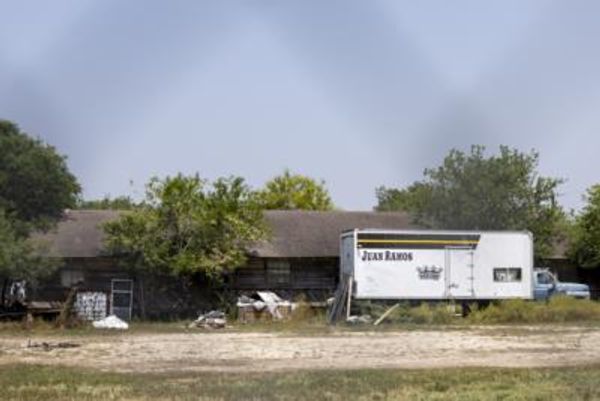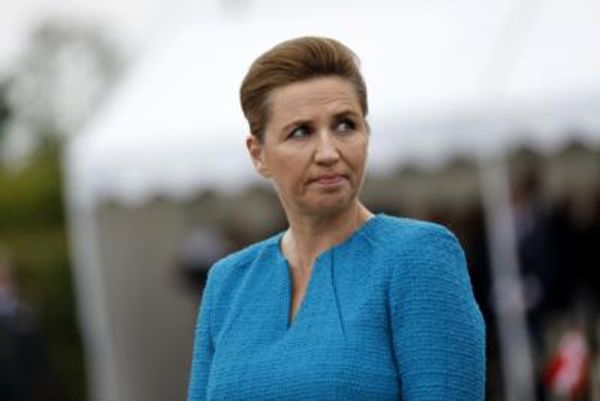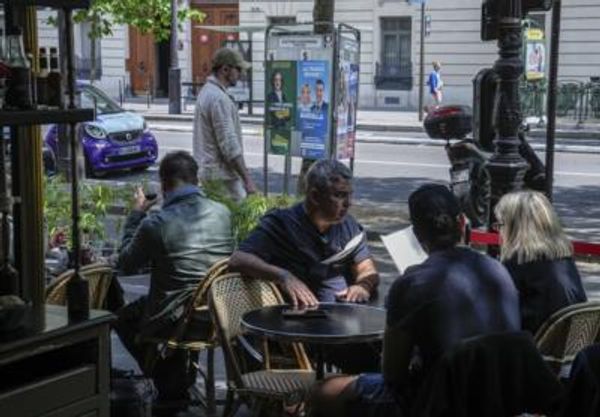
‘Emmanuel Macron? No, we have nothing at all. People were happy for a day or two after he was elected, but now they all hate him.” It was a disappointing response from a souvenir shop owner in the heart of Paris between the Boulevard St Germain and Notre-Dame. Figurines of Marianne, models of the Eiffel Tower and tricolore-draped bric-a-brac were ranged on shelves looking out over the Seine on my visit in 2018. But there was not a hint of the newish man in the Élysée. Not a single bust, figurine, badge or plate. Rien.

Franklin D Roosevelt and Winston Churchill globe cup celebrating the 1941 Lend-Lease agreement to provide support for the allies before the US entered the war. The inscription is: ‘Let’s drink to victory. Let’s drink to peace.’ Bought in Portobello Road, London, 2012
I have been collecting political memorabilia for 40 years. It is a pleasurable, but occasionally frustrating, business. Greed and obsession can be a problem, too – and that may well be an understatement. The truth is that I already owned a Macron, albeit encased in one of those tacky plastic snowstorm bubbles, along with hundreds of other objects displayed on cramped shelves in our dining room, which friends, guests and neighbours are generally astounded by on first sight.
The main point, however, is in seeing how political leaders – monarchs, dictators and democrats – have been portrayed in the past and present: how sycophantic admirers revere them; how angry opponents or imaginative artists and canny manufacturers choose to present them; and how poking fun becomes an evocative part of the historical record.

Above, from left to right, and top to bottom: Angela Merkel lemon squeezer; Benito Mussolini figurine; badge commemorating Beirut protests against the Ottomans; Ghiyath Matar candle and ‘We will not forget you’ scroll; former Uzbek president Islam Karimov plate and Bernie Sanders Bernie or Bust badge; Margaret Thatcher nutcracker; Brexit Express badge; unidentified pipe; Winnie Mandela; Rosie the Riveter; Juan and Eva Perón busts; Muammar Gaddafi watch; Helmut Schmidt dog; Roosevelt and Churchill globe; Wooden map of Lebanon; Queen Elizabeth II clockwork doll; Desmond Tutu figurine; Gamal Abdel Nasser embroidered bag; Greta Thunberg doll; King of Bahrain badge; Donald Trump toilet brush; Ruth Bader Ginsburg; Gibraltar monkey; David ‘Dunce’ Cameron; Israel’s second prime minister, Moshe Sharett; Egyptian singer Umm Kulthum; Vladimir Putin salt cellar; Barack Obamamints and Donald Trump Impeachmints; Hafez al-Assad plaque; former Palestinian leader Yasser Arafat; Mikhail Gorbachev; Tsar Nicholas doll; Otto von Bismarck nutcracker; second world war medal; Hillary Clinton doll; Boris Johnson Bollocks to Brexit keyring; clockwork Jimmy Carter peanut; Arafat plate; Ronald and Nancy Reagan Spitting Image slippers; Israeli gas mask figurine; former mayor of Jerusalem Teddy Kollek badge; Sarah Palin badge; badge of Israeli human rights group B’Tselem; unidentified matryoshka doll; Mahatma Gandhi; Kemal Atatürk tableau; doll of former Israeli prime minister David Ben-Gurion; Brexit badge; Saddam Hussein ‘So Damn Insane’ badge
Donald Trump provided a bonanza for memorabilia maniacs like me: bobble-heads display his distinctive haircut. His confrontation with Kim Jong‑un is commemorated in a “Tweety Boy Trump” wrestler figure pitted against “Little Kim Rocketman”. Squeeze the President Dump keyring, and an unpleasant-looking brown bubble emerges from his massive plastic buttocks. A Trump toilet brush at least has a practical use (although mine is on display and not in the loo). But the last occupant of the White House is not the only leader to inspire scatological portrayal. There is an entire series of traditional Catalan caganer figurines depicting high-level poopers – including Boris Johnson and US vice-president Kamala Harris.
Trump is, of course, an unusually divisive figure. But he is not alone: Vladimir Putin, generating global headlines because of his widely condemned invasion of Ukraine, exists in the formal plaster or bronze bust commemorating Soviet-era leaders from Lenin and Stalin onwards – as well as in traditional matryoshka (“little matron”) dolls that have been available of Russian leaders since Mikhail Gorbachev ushered in perestroika. (I actually have a fine Leon Trotsky bust, bought in New York, though I’m sure it can’t have been made in the USSR.) A macho Putin riding a bear is available from a Russian manufacturer. But in the US you can also buy a Putin pencil sharpener with the pencil up his rear end.
The Middle East is an exotic treasure trove of kitschy political memorabilia. Authoritarian regimes have ruled the region more or less since the fall of the Ottoman empire. It is also rife with conflict, including the issue of Israel and Palestine. My favourite item from that region is one I found in Bethlehem in the mid-noughties: an olive-wood model of a traditional manger scene divided by Israel’s separation wall, symbolising the reality of the continuing occupation. A close second is a large doll of Israel’s first prime minister, David Ben‑Gurion, with his long, messy hair.

Tableau featuring Mustafa Kemal, AKA Kemal Atatürk, the founder and first president of the post-Ottoman Turkish Republic, 1923-38. Atatürk is flanked by a soldier and a female worker. It is inscribed: ‘Turk, be proud, work and trust’. Bought in Istanbul in 2004


Above left: plaque of Hafez al-Assad, autocratic Syrian president from 1971-2000, whose son Bashar suppressed the Arab spring uprising and still rules. Above right: nutcracker featuring Prussian and German leader Otto von Bismarck, known as the ‘Iron Chancellor’ for his tough and savvy diplomatic skills
The Middle East is also the part of the world where I spent much of my working life as a journalist, including 36 years at the Guardian. Highlights of my collection include a brass portrait of a glowering Saddam Hussein bought in Baghdad after the end of the eight-year war with Iran. From the mid-1980s I made several nerve-racking trips to Iran, where the conflict with Iraq was always billed as a western-backed conspiracy against the Islamic revolution. Prizes from Tehran included a ceramic tile bearing the stern features of Ayatollah Khomeini, as well as a copper profile of the late Shah, Mohammad Reza Pahlavi. I bought that in an antique shop adjacent to the British embassy, close to Bobby Sands Street – provocatively named after the IRA hunger striker.
Then there was the period from 1993 to 1999, when I lived in London, covering diplomatic and international affairs. I still managed to find a delicate figurine of Mahatma Gandhi in Exmouth market (near the Guardian’s old office on Farringdon Road), a tiny statuette of Paul von Hindenburg (the German chief of staff during the first world war and its interwar president) in Brighton, and an Abraham Lincoln bust while visiting New York to cover the UN general assembly. I also came across a silver metal bust of the Bulgarian president Todor Zhivkov, who ruled his country for 35 years, while reporting on an eastern European tour by Robin Cook, Tony Blair’s first foreign secretary. Part of the pleasure is finding niche figures – the ones little celebrated outside their home countries.

Candle and scroll inscribed ‘We will not forget you’, commemorating Syrian activist Ghiyath Matar, who was known for giving flowers to soldiers, and was killed by state security forces in 2011. There is a film about Matar, called Little Gandhi


Above left: busts of Juan Perón, president of Argentina from 1946-55 and 1973-74, and his wife, Eva, a working-class actor and accomplished speaker, immortalised in 1976 in the rock opera Evita and the song Don’t Cry for Me Argentina. Above right: figurine of Desmond Tutu, the South African archbishop and anti-apartheid activist who died in December 2021, part of a fine Zapiro caricature series
In 2000, I was sent to Brussels. It was not easy covering the EU because of its institutional complexity – and it certainly wasn’t a barrel of laughs. But regular European travel, combined with visits to local flea markets, meant that the opportunities for collecting were endless. I added a statue of King Christian X of Denmark, riding his horse through the streets of Copenhagen in defiance of the Nazi occupation. In Warsaw that summer I found a plaque of Jósef Piłsudski (Poland’s interwar leader) for the złoty equivalent of a few quid. On holiday near Ljubljana, the Slovenian capital, I acquired a bust of Marshal Tito, the founder of Yugoslavia. The Waterloo flea market, south of Brussels, became a favourite destination: there, I found a copper bust of France’s interwar prime minister Raymond Poincaré, a stone one of an unsmiling Adolf Hitler (illegal in Germany) and a resin one of the Belgian king Leopold II, the brutal imperial ruler of Congo. No historical monster is beyond the pale; my wife has had to learn to share our home with the villains of my collection. By contrast, one specialist US website has a category entitled “respectable collectables”.
Sweden presided over the council of EU ministers from January 2001. Work trips to Stockholm produced two exceptionally good pieces from Europe’s past: Benito Mussolini and Charles de Gaulle, both carved wooden figurines with instantly recognisable features. A visit to Naples produced yet another Mussolini – a big, helmeted bust – as well as Silvio Berlusconi, with his Forza Italia party manifesto, in glazed terracotta in the folkish style of presepio (nativity scene) figures.
Moving back to London in 2004 produced an inevitable switch to British political leaders: I got hold of Neville Chamberlain, Harold Wilson and Roy Jenkins in quick succession. All were toby jugs, a classic British form of caricature in clay, dating back to the late 18th century. Small rubber dolls inspired by the Spitting Image TV series (though not the ones used in the show) were a more up-to-date version of those, with Blair and SDP leader David Owen.
More spectacular was Osama bin Laden, complete with turban, dishdasha and automatic pistol. Bin Laden was a gift from Alan Rusbridger, the then Guardian editor, in October 2002, just over a year after the 9/11 attacks. I was on my way from Brussels to Dublin, via the London office, when I was given it. Boarding the Dublin flight, I invited problems with security by carrying Bin Laden in my hand luggage, which was scanned. But they laughed out loud. The doll and I made it safely home to Brussels after the EU summit. The only person who was really upset was my 11-year-old daughter who came home from school and was horrified to find Bin Laden – whom the whole world was then hunting – seated grinning at our dining table.


Above left: Osama bin Laden Spitting Image puppet – a similar one sold at Sotheby’s in 2001 and the cash was split between Afghan refugees and victims of the World Trade Center attacks. Above right: rug depicting Muammar Gaddafi, Libyan leader, 1969-2011, obtained from secret police HQ, Tripoli, 2011
In the mid-noughties, I found several great items in a shop in Portobello Road, London. Its owner specialised in the brilliant works of an Argentinian cartoonist called Lino Palacio – known as Flax – which were turned into superbly detailed and funny figurines. I own US president Franklin D Roosevelt and wartime Japanese general and prime minister Hideki Tojo. They were quite pricey (£110 each), but I still wish I had bought many more.
The Middle East and north Africa remained an abiding source of interest. The Arab spring, which erupted in Tunisia in late 2010, provided not just hope for the region’s oppressed peoples, but a chance to expand my collection. An old friend later said: “I imagine you getting sent to far-flung corners of the world on a purchasing mission, while trying to fit in your day job.”
In September 2011 I was in Tripoli, reporting on the aftermath of the Libyan uprising. Muammar Gaddafi was still alive. I was working with a Guardian colleague, Ghaith Abdul-Ahad, and someone told us rebel forces had taken over a state mukhabarat (secret police) HQ. The free gift there was familiar from hotel lobbies and endlessly photographed after the revolution being trampled on by ordinary Libyans: a mass-produced carpet, featuring a portrait of a handsome young colonel. Within weeks, Gaddafi would be killed near his home town of Sirte. But he lives on, warts and all, on our dining-room floor.
Friends, colleagues and family have contributed a great deal to what I have taken to describing as “you-know-what” or just “the collection”. Buying online – from eBay, Etsy and specialist websites – is far less interesting than looking in real life, but that has been the only way to scratch that constant itch during the Covid pandemic.

Political Memorabilia, including Vladimir Putin lorem ipsum, Margaret Thatcher lorem ipsum and something else lorem ipsum. Photograph: Liz McBurney/The Guardian
Above, from left to right, and top to bottom: Israeli statesman Moshe Dayan; Nelson Mandela plate; Abdel-Fatah al-Sisi badge; Danish EU referendum badge; Bernie Sanders doll; former Turkish president Ismet Inönü; Jacques Chirac; Zionist leader Vladimir Jabotinsky; Amnesty and Bahraini non-sectarian badges; George Bush Sr; George W Bush; pan-European beer mat; Bill Clinton bottle stopper; Pope Francis; Jeremy Corbyn doll; Ottoman Sultan Abdulhamid; Putin dog toy; 1997 Denver G8 summit badge; Moroccan rabbi Baba Sali clock; No More Chernobyls badge; 1998 Birmingham G8 summit badge; map of Africa bath plug; Charles de Gaulle nutcracker; Nicolas Sarkozy doll; Prince Philip clockwork toy; TE Lawrence (of Arabia); Martin Luther King Jr; plate featuring Iranian Ayatollahs Khomeini and Khamenei; Israeli soldier; David Cameron badge; Mandela tea; Joe Biden figurine; Mikhail Gorbachev; Portuguese dictator António Salazar; William Hague; Stalin candle; Farsi political badge; Mussolini bust; Hong Kong 1997 badge; figurine of father of Zionism Theodor Herzl; Kim Jong-un; Margaret Thatcher; Kamala Harris badge; Kuwait flag badge; Soviet medal; Theodor Herzl tile
We don’t own a dog, but another distinct category is softish toys for pets, which, despite their own views, enjoy playing with and biting political leaders. So far I have Johnson, Keir Starmer, Nigel Farage, Theresa May, Priti Patel and Nicola Sturgeon. International characters include Trump and Joe Biden. Not long ago I had to wrestle one of them (it was Trump) from the jaws of a guest’s spaniel who assumed, quite reasonably, that it was for playing with. Smaller versions are available for cats, all produced by Pet Hates Toys. I also found a sizeable Putin (made in China), but, unsurprisingly, I haven’t yet come across a Xi Jinping for animals.
Brexit provided some items – though as a remainer I boycotted leave campaign slogans and T-shirts. I was briefly tempted to buy the 50p coin commemorating the UK’s departure, but was put off by its ridiculous price – £80 to £650 on eBay! My favourite piece is a keyring, saying “BOLLOCKS TO BREXIT: It’s not a done deal”, which hangs on a cartoonish Boris figurine. If only …
Over the years I have come to believe that I cannot be too pedantic in what I define as political. There is cultural stuff representing popular national figures – the famous Egyptian singer Umm Kulthum (found in Cairo) and the Good Soldier Švejk, from the Czech novel by Jaroslav Hašek that has been translated into more than 50 languages (picked up in Prague). Another favourite is a wooden plaque, bought in Beirut, bearing the moving words of writer and artist Kahlil Gibran: “If Lebanon was not my homeland I would have chosen it as my homeland.” I also have Rosie the Riveter, the symbol of American determination during the second world war, and a feminist icon.
But it is not only about having attractive objects on display. Lots of items are practical, too, though I draw the line at actually using them. These include a Vichy-État bottle opener, a Bill Clinton bottle stopper and a De Gaulle nutcracker. For ages I’ve had my eye on another Hitler, dating back to 1941, with his cloth-covered rear end serving as a pin cushion. But so far I have resisted the temptation. I also have a Blair chocolate lollipop, Nicolas Sarkozy and other French politicians teabags, an Angela Merkel lemon squeezer, a Roosevelt pencil sharpener, a Putin salt cellar and a Michael Foot candle. And then there is the Trump toilet paper …







